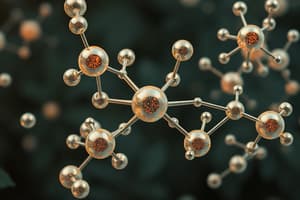Podcast
Questions and Answers
What is the primary chemical composition of lipids?
What is the primary chemical composition of lipids?
- C, H, O (correct)
- C, H, O, N
- C, H, O, N, S
- C, H, O, P
Lipids are considered polymers composed of monomers.
Lipids are considered polymers composed of monomers.
False (B)
What percentage of adult body mass do lipids represent?
What percentage of adult body mass do lipids represent?
18-25%
Lipids are primarily found in three compartments in the body: plasma, biological membranes, and __________.
Lipids are primarily found in three compartments in the body: plasma, biological membranes, and __________.
Match the types of fatty acids to their classifications:
Match the types of fatty acids to their classifications:
What is one of the main roles of lipids in the body?
What is one of the main roles of lipids in the body?
Lipids yield less energy when oxidized compared to carbohydrates.
Lipids yield less energy when oxidized compared to carbohydrates.
What are the two classifications of lipids based on the saponification reaction?
What are the two classifications of lipids based on the saponification reaction?
The general formula for fatty acids is ___(R-COOH).
The general formula for fatty acids is ___(R-COOH).
Match the following types of lipids with their characteristics:
Match the following types of lipids with their characteristics:
Flashcards
Lipids
Lipids
A heterogeneous group of organic compounds related to fatty acids, including fats, oils, and waxes. They are hydrophobic and insoluble in water.
Fatty Acids
Fatty Acids
A component of lipids; long hydrocarbon chains with a carboxylic acid group at one end.
Saturated Fatty Acids
Saturated Fatty Acids
Fatty acids with no double bonds between carbon atoms in their hydrocarbon chains.
Unsaturated Fatty Acids
Unsaturated Fatty Acids
Signup and view all the flashcards
Hydrophobic
Hydrophobic
Signup and view all the flashcards
Biomolecules
Biomolecules
Signup and view all the flashcards
Adipose Tissue
Adipose Tissue
Signup and view all the flashcards
Lipids: Biological Importance
Lipids: Biological Importance
Signup and view all the flashcards
Lipid Membrane Structure
Lipid Membrane Structure
Signup and view all the flashcards
Lipid Energy Storage
Lipid Energy Storage
Signup and view all the flashcards
Lipid Insulation
Lipid Insulation
Signup and view all the flashcards
Lipid Protection
Lipid Protection
Signup and view all the flashcards
Saponifiable Lipids
Saponifiable Lipids
Signup and view all the flashcards
Non-Saponifiable Lipids
Non-Saponifiable Lipids
Signup and view all the flashcards
Fatty Acids (FAs)
Fatty Acids (FAs)
Signup and view all the flashcards
Fatty Acid Structure
Fatty Acid Structure
Signup and view all the flashcards
Fatty Acid Amphipathic Nature
Fatty Acid Amphipathic Nature
Signup and view all the flashcards
Study Notes
Lipids
- Lipids are molecules produced by living organisms.
- Lipids, nucleic acids, carbohydrates, and proteins are the four main organic biomolecules.
- Minerals and vitamins are also considered biomolecules.
- Biomolecules are the building blocks of life, and perform various important functions in living organisms.
- A fundamental relationship exists between the structure and function of biomolecules, influenced by the environment.
Structure & Functions of Lipids
- The course aims to provide knowledge about different classes of lipids, including their chemical structure, properties, and functions.
Biomolecules (Biological molecules)
- Lipids are a major class of tissue components and food stuffs, first defined in 1943.
- Lipids are a heterogeneous group of organic compounds that include fats, oils, waxes, etc.
- They are oily, greasy, and relatively insoluble in water and other polar solvents.
- They are soluble in nonpolar organic solvents (ether, chloroform, benzene, acetone).
- Lipids are hydrophobic due to hydrocarbon chains (-CH2-CH2-CH2-CH2-) in their structures.
What Are Lipids?
- The word lipid comes from the Greek word "lipos," meaning fat.
- Lipids are widely distributed in nature, both in plants and animals.
- Lipids make up 18-25% of adult body mass.
- In the human body, lipids are primarily found in plasma, biological membranes, and adipose tissue.
- Adipose tissue is a loose connective tissue designed to store fat (in adipocytes) under the skin, around kidneys, in the abdomen, and breasts.
Biological Importance of Lipids
- Lipids are structural components of biological membranes and nerves (e.g., glycolipids, phospholipids, sphingomyelins, cholesterol & lipoproteins) and maintain membrane fluidity.
- Lipids serve as energy reservoirs, storing energy more efficiently and palatably than carbohydrates, yielding twice the energy.
- Lipids act as thermal insulators in subcutaneous tissues, protecting against heat loss.
- Lipids provide protective cushions for internal organs and protective coats for organisms.
- Lipids are involved in cell-cell adhesion, cell recognition, and tissue immunity.
- Lipids function as surfactants and emulsifying agents aiding in dietary fat digestion and absorption (e.g., bile acids, lecithins).
- Lipids act as cellular metabolic regulators and modulators, and intracellular messengers (e.g., steroid hormones, prostaglandins, inositol triphosphate I3P).
- Lipids provide essential fatty acids and fat-soluble vitamins (A, D, E, & K).
- Lipids are components of the electron transport chain (e.g., ubiquinone: Coenzyme Q).
Classification of Lipids
- Saponification Classification System: Based on the saponification reaction (ester hydrolysis in basic conditions using KOH).
- Saponifiable lipids: Triglycerides, waxes, phospholipids, and glycolipids.
- Non-Saponifiable lipids: Steroids, terpenes, Vitamins, and eicosanoids.
- Bloor's Classification System: Based on chemical composition of lipids.
- Simple Lipids: Fats & Oils, Waxes.
- Compound Lipids: Phospholipids, Glycolipids, Lipoproteins, and Glycerophospholipids, Sphingophospholipids, Glyceroglycolipids, Glycosphingolipids.
- Derived Lipids: Steroids, Fatty acids, Terpenes, and Carotenoids.
Fatty Acids (FAs)
-
Fatty acids are aliphatic monocarboxylic organic acids (R-COOH) with a hydrocarbon chain.
-
The carboxyl group (COOH) is at one end, and the hydrocarbon chain (often CH3-) at the other end.
-
Fatty Acids (FAs) are amphipathic, having both hydrophilic (water-loving) and hydrophobic (water-fearing) regions.
-
FAs are esters, not free, and form natural fats and oils.
-
There are over 100 different FAs in nature. Most FAs in the body are esterified (90%).
-
Fatty Acid Classification: Based on the number of carbon atoms and degree of saturation, classified into:
-
Chain Length: Short (2-6 C), Medium (8-10 C), Long (10-24 C), Very long.
-
Nature of Chain: Straight, Branched, Cyclic, Substituted.
-
Total C Atoms: Even or Odd.
-
Degree of Saturation: Saturated, Monounsaturated, Polyunsaturated.
Straight Chain Fatty Acids
- These have a linear arrangement of carbon atoms in the alkyl chain.
- Even-numbered FAs, such as palmitic acid (16:0), are most abundant.
- Some odd-numbered FAs, like propionic acid (3:0), are found in some plants and marine organisms.
- The degree of saturation is determined by the presence or absence of double bonds.
I-Saturated Fatty Acids (SFAs)
- SFAs are fatty acids with straight single bonded hydrocarbon chains.
- They are packed closely together in a compact structure
- Their volatility and water solubility depend on chain length.
- Short-chained SFAs are volatile and water-soluble; long-chained SFAs are non-volatile and water-insoluble.
I-Saturated FAs, Nomenclature
-
Fatty acid carbon atoms are numbered from the carboxyl group (COOH) end or the terminal methyl group (omega, ω).
-
The carboxyl group is often referred to as ω-C1, which is the first carbon atom, and adjacent carbons (α, β, γ,...).
-
Systematic Naming: The systematic name is derived from its parent hydrocarbon chain and by adding 'oic acid'.
I-Saturated Fatty Acids (SFAs) (Palmitic & Stearic Acids)
- Palmitic (16:0) and stearic (18:0) acids are the most prevalent SFAs in animal cells.
- Longer R (hydrocarbon) chains mean higher melting points due to increased energy needed to break hydrophobic interactions.
Studying That Suits You
Use AI to generate personalized quizzes and flashcards to suit your learning preferences.
Related Documents
Description
This quiz explores the diverse classes of lipids, their chemical structures, properties, and essential functions in living organisms. Gain insights into the role of lipids as a major category of biomolecules and how they interact with the environment. Ideal for students studying biomolecules.




